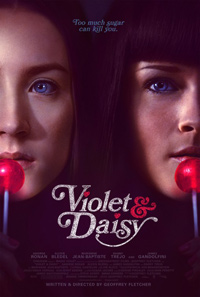 Flowery Assassins Will Make You Cringe, Just Not In The Way Fletcher Intended
Flowery Assassins Will Make You Cringe, Just Not In The Way Fletcher Intended
Violet & Daisy the directorial debut of Geoffrey Fletcher is without the authenticity offered by his 2010 Oscar winning screenplay for Precious. In the film, a freshly launched clothing line by pop-star Barbie Sunday is apparently hot enough to kill for, as it provokes teenaged girlfriends to accept an assassin job. The bubblegum-snapping Violet (Alexis Bledel) and Daisy (Saoirse Ronan) had already been working freelance in this vein of criminality before the coveted dress collection was made available, a narrative detail that devalues the potential subtext on the moral toxicity of consumer culture. While the prospect of procuring designer threads is too weak an explanation for such a brutal career path, it is only the tip of a massive iceberg of implausibility.
Fletcher makes an attempt to channel the eccentric dialogue and explosive violence characteristic of Pulp Fiction, a film that notably subordinates narrative believability to ultra-hip banter and a fully achieved aesthetic. In the opening sequence, Violet tells a story about a bachelor veterinarian that is too hard on himself for sleeping with his patients. The joke is lost on the unbearably naive Daisy, but none the less becomes irrelevant as they begin to unload on some thugs, much like the infamous debate on the sexual implications of a foot massage that is dropped when Vincent Vega and Jules massacre a stoned clique of delinquent dealers.
The film has a polished and perceptible visual style and the charming old-timey lingo is consistently amusing. Yet the gunfights more closely resemble a video game than shocking Tarantino gore and the ultimately purposeless violence only underlines gaps in plausibility.
Violet and Daisy are forcefully marked as infantile through heavy-handed signifiers of stunted maturity – lackadaisical pat-a-cake gestures, the use of “stupid” as a wounding insult and traveling by tricycle. This childishness only makes Violet’s sporadic bad girl vernacular feel more contrived and fails to account for the callous violence. Perhaps the most unforgivable and inhuman display is the invented “internal bleeding dance” where the girls frolic across bleeding bodies as if jumping on a bed at a slumber party.
Their professionalism is challenged by the task of assassinating the lovable Michael (James Gandolfini) who placed a hit on himself and immediately showers the perplexed girls with paternal affection and freshly baked cookies. All tuckered out, Violet and Daisy even share a bed with Michael, an image that would be a heartwarming visual of unblinking trust if their unusual relationship had developed at a more natural pace. Furthermore, the implicit impossibility of Michael making even the slightest advance towards the blue-eyed beauties simply confirms the one-dimensionality of his idealized characterization as a father figure. It is this absence of convincing human impulses and emotion that prevents any real viewer connection with Violet & Daisy.


